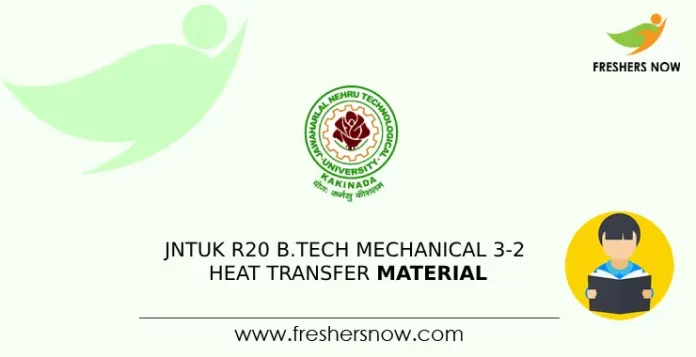
JNTUK R20 B.Tech Mechanical 3-2 Heat Transfer Material/ Notes PDF Download: JNTUK R20 B.Tech Mechanical 3-2 Heat Transfer Material provides a clear understanding of heat transfer for mechanical engineering students. It covers various topics such as heat transfer mechanisms, including conduction and convection, and explains concepts like forced and free convection in fluids. Additionally, students learn about heat transfer with phase change, condensation, and heat exchangers. The material also includes radiation heat transfer.
With easy-to-understand explanations and comprehensive JNTUK R20 B.Tech Mechanical 3-2 Heat Transfer Notes, students can enhance their understanding and excel in their studies. For JNTUK R20 B.Tech Mechanical 3-2 Heat Transfer Material notes and PDF downloads, students have all the resources they need to succeed.
JNTUK R20 B.Tech Mechanical 3-2 Heat Transfer Material – Units
| No. Of Units | Name of the Unit |
| Unit – 1 | Introduction, Conduction Heat Transfer, One Dimensional Steady State Conduction Heat Transfer |
| Unit – 2 | One Dimensional Transient Conduction Heat Transfer, Convective Heat Transfer |
| Unit – 3 | Forced convection: External Flows, Internal Flows, Free Convection |
| Unit – 4 | Heat Transfer with Phase Change, Condensation, Heat Exchangers |
| Unit – 5 | Radiation Heat Transfer |
Unit 1 Syllabus PDF Download | JNTUK R20 B.Tech Mechanical Heat Transfer Material
Introduction: Modes and mechanisms of heat transfer – Basic laws of heat transfer –General discussion about applications of heat transfer.
Conduction Heat Transfer: Fourier rate equation – General heat conduction equation in Cartesian, Cylindrical and Spherical coordinates – simplification and forms of the field equation – steady, unsteady and periodic heat transfer – Initial and boundary conditions
One Dimensional Steady State Conduction Heat Transfer: Homogeneous slabs, hollow cylinders and spheres- Composite systems– overall heat transfer coefficient – Electrical analogy – Critical radius of insulation. Variable Thermal conductivity – systems with heat sources or Heat generation-Extended surface (fins) Heat Transfer – Long Fin, Fin with insulated tip and Short Fin, Application to error measurement of Temperature.
| JNTUK R20 B.Tech Mechanical 3-2 Heat Transfer Material – PDF Download | |
| To Download The JNTUK R20 B.Tech Mechanical 3-2 Heat Transfer Unit 1 Notes PDF | Download PDF |
Unit 2 Syllabus PDF Download | JNTUK R20 B.Tech Mechanical Heat Transfer Material
One-Dimensional Transient Conduction Heat Transfer: Systems with negligible internal resistance – Significance of Biot and Fourier Numbers –Infinite bodies- Chart solutions of transient conduction systems- Concept of Semi-infinite body.
Convective Heat Transfer: Classification of systems based on causation of flow, condition of flow, configuration of flow, and medium of flow – Dimensional analysis as a tool for experimental investigation – Buckingham π Theorem and method, application for developing semiempirical dimensional correlation for convection heat transfer – Significance of non-dimensional numbers – Concepts of Continuity, Momentum and Energy Equations
| JNTUK R20 B.Tech Mechanical 3-2 Heat Transfer Material – PDF Download | |
| To Download The JNTUK R20 B.Tech Mechanical 3-2 Heat Transfer Unit 2 Notes PDF | Download PDF |
Unit 3 Syllabus PDF Download | JNTUK R20 B.Tech Mechanical Heat Transfer Material
Forced convection: External Flows: Concepts about hydrodynamic and thermal boundary layer and use of empirical correlations for convective heat transfer -Flat plates and Cylinders.
Internal Flows: Concepts about Hydrodynamic and Thermal Entry Lengths – Division of internal flow based on this –Use of empirical relations for Horizontal Pipe Flow and annulus flow.
Free Convection: Development of Hydrodynamic and thermal boundary layer along a vertical plate – Use of empirical relations for Vertical plates and pipes.
| JNTUK R20 B.Tech Mechanical 3-2 Heat Transfer Material – PDF Download | |
| To Download The JNTUK R20 B.Tech Mechanical 3-2 Heat Transfer Unit 3 Notes PDF | Download PDF |
Unit 4 Syllabus PDF Download | JNTUK R20 B.Tech Mechanical Heat Transfer Material
Heat Transfer with Phase Change: Boiling: Pool boiling – Regimes – Calculations on Nucleate boiling, Critical Heat flux, and Film boiling
Condensation: Film-wise and drop-wise condensation –Nusselt’s Theory of Condensation on a vertical plate – Film condensation on vertical and horizontal cylinders using empirical correlations.
Heat Exchangers: Classification of heat exchangers – overall heat transfer Coefficient and fouling factor – Concepts of LMTD and NTU methods – Problems using LMTD and NTU methods.
| JNTUK R20 B.Tech Mechanical 3-2 Heat Transfer Material – PDF Download | |
| To Download The JNTUK R20 B.Tech Mechanical 3-2 Heat Transfer Unit 4 Notes PDF | Download PDF |
Unit 5 Syllabus PDF Download | JNTUK R20 B.Tech Mechanical Heat Transfer Material
Radiation Heat Transfer: Emission characteristics and laws of black-body radiation – Irradiation – total and monochromatic quantities – laws of Planck, Wien, Kirchhoff, Lambert, Stefan, and Boltzmann– heat exchange between two black bodies – concepts of shape factor – Emissivity – heat exchange between grey bodies – radiation shields – electrical analogy for radiation networks.
| JNTUK R20 B.Tech Mechanical 3-2 Heat Transfer Material – PDF Download | |
| To Download The JNTUK R20 B.Tech Mechanical 3-2 Heat Transfer Unit 5 Notes PDF | Download PDF |
JNTUK R20 B.Tech Heat Transfer Material – Outcomes
- Apply knowledge of heat transfer mechanisms and modes.
- Understand concepts of conduction and convective heat transfer.
- Learn about forced and free convection.
- Analyze heat transfer with phase change, condensation, and heat exchangers.
- Interpret knowledge about radiation heat transfer.
For more details about JNTUK R20 B.Tech Mechanical 3-2 Heat Transfer Material and other materials follow our official website Freshersnow.com.



